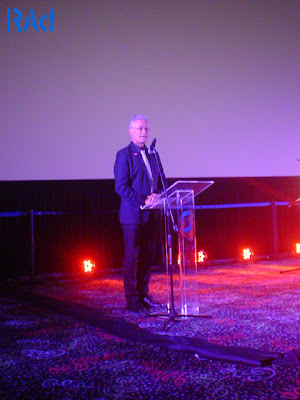Film
Festivals at the Shangri-La Plaza have been very popular among movie buffs
because not only do they get the chance to see films that are unique but they
get to see it for free. No wonder that a lot of people line up in order to get
tickets to see these films and a lot of times, the time spent lining up to get
the free tickets is actually longer than the duration of the film itself. Such
is the appeal and drawing power of these film festivals and the 5th
International Silent Film Festival was no exception.
 |
Richard Künzel, Director of Goethe-Institut
Philippinen
|
The
films shown during this festival may be old but the addition of live music
performance during the screening of the films makes it a unique experience that
film buff dare not miss. And add to that the fact that each film is only
screened once truly make tickets for each screening in such high demand.
Fortunately for me, I didn’t have to worry about lining up and securing tickets
thanks to the Japan Foundation, Manila
Brides
of Sulu
Before
the screening of this film, Teddy Co from Society of Filipino Archivists for Film (SOFIA) US
Nosferatu
While
the first film screened was an obscure one, the next film Nosferatu from Germany
I
was seated at the section where the subtitles were obscured by some members of
the choir. But since the memory of the novel Dracula was still fresh, I was
still able to follow the flow of the story. But my attention during the
screening was more focused on the music and at von Bothmer along with the FEU
Chorale. I think that the music composed by von Bothmer was scarier and
creepier than the film itself. The film seemed so well polished that it didn’t scare me at all. Count Orlok did look scary but the film wasn’t able to set
the mood in order to make everything a lot scarier. Since film making was still
in its early stages back then, I was more forgiving. Thankfully, the music gave the film more character and was very successful in establishing the mood, conveying horror and suspense as well.
What
really fascinated me the most about the two films was that they were glimpses
of a time that has come and gone. I realized that everyone involved in these
films are already dead and yet their work lived on. It’s just a shame that many
more films from the silent era weren’t preserved and got lost never to be
recovered. It’s odd that I was only supposed to watch a couple of silent films
with live music accompaniment and yet my mind wandered off into thoughts of
ages past. It might be that I’m getting older and getting more nostalgic but I’d
like to believe that it’s just proof that there’s more to a film than what was
just screened inside the theater.






No comments:
Post a Comment